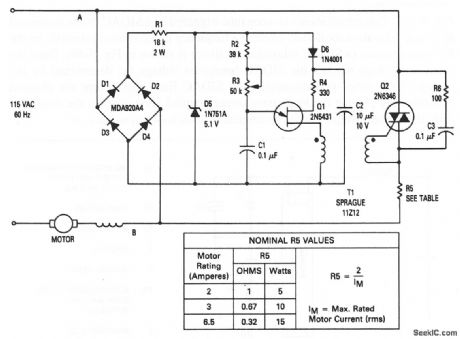Control Circuit
Motor_speed_control_with_load_current_feedbac
Published:2009/7/21 22:41:00 Author:Jessie | From:SeekIC

This circuit shows a triac motor-speed control that derives feedback from the load current and does not require separate connections to the motor field and armature windings. Thus, this circuit can be conveniently built into an appliance or used as a separate control, When the triac conducts, in response to signals from Q1 through T1, the normal line voltage (less the drop across the triac and R5) is applied to the motor. By delaying the firing of the triac until a later portion of the cycle, the voltage applied to the motor is reduced (or controlled) and speed is reduced proportionally. The use of feedback maintains torque at reduced speeds. The angle at which Q1 fires is proportional to motor current (and the setting of R3) because Q1 is controlled by the voltage across points A and B. As the motor is loaded and draws more current, the firing angle of Q1 is advanced, causing a proportional increase in the voltage applied to the motor, and a consequent increase in the available torque.
Reprinted Url Of This Article:
http://www.seekic.com/circuit_diagram/Control_Circuit/Motor_speed_control_with_load_current_feedbac.html
Print this Page | Comments | Reading(3)

Article Categories
power supply circuit
Amplifier Circuit
Basic Circuit
LED and Light Circuit
Sensor Circuit
Signal Processing
Electrical Equipment Circuit
Control Circuit
Remote Control Circuit
A/D-D/A Converter Circuit
Audio Circuit
Measuring and Test Circuit
Communication Circuit
Computer-Related Circuit
555 Circuit
Automotive Circuit
Repairing Circuit
Code: